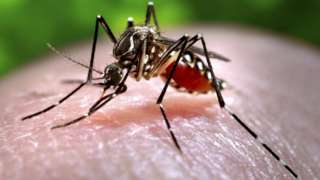
c/o bbc.com
The Zika virus was once thought to be restricted to tropical areas of Africa, Southeast Asia, and the Pacific Islands. Declared a “public health emergency of international concern” by the World Health Organization (WHO), it has spread to pandemic scale and has garnered coverage similar to that given to Ebola in 2015. According to the Center for Disease Control (CDC), Zika is transmitted by the Aedes mosquito, the same mosquito responsible for transmitting dengue fever and chikungunya. In Brazil, the outbreak of the virus has been linked to reports of the onset of other neurological conditions, including Guillain-Barré Syndrome, a potentially life-threatening autoimmune disease, and microcephaly in newborns, resulting in underdeveloped brains. The spread has gotten so bad that the government of El Salvador has encouraged its citizens not to have children for the next two years, an especially tall order considering that the country is extremely conservative and has a population that is roughly 50 percent Roman Catholic.
Zika has existed in the tropical regions of developing countries since the 1940s, spiking intermittently. But it hasn’t appeared on any scale of note since it was discovered. So why now?
As Michael T. Osterholm notes in his New York Times article on the topic, the mosquito that spreads the virus is more common than ever. It has adapted to use modern waste as a habitat. Osterholm astutely points out that vector control, or the use of chemical insecticides to eliminate both adult mosquitoes and their breeding sites, was attempted in the Americas and failed because of budget reasons. Today, this solution holds little water, as the variety and availability of makeshift habitats for these mosquitoes has exploded. Instead of concerning ourselves with vector elimination, Osterholm writes, we must develop a vaccine.
However, vaccine development poses a problem. Activists point out the perceived 10/90 gap, which states that only 10 percent of research on global health goes toward the diseases that affect 90 percent of the population, or so-called “neglected diseases.” The WHO answers this in a piece entitled “Diseases of Poverty,” in which it explains that these tropical diseases don’t account for significant portions of the mortality rates of those countries. Instead, lack of access to basic sanitation and vaccination is the real problem. According to the WHO, “an estimated 30 percent of the world population lacks regular access to existing drugs, with this figure rising to over 50 percent in the poorest parts of Africa and Asia.” As such, developing universal vaccines, such as Osterholm’s proposed universal influenza vaccine, would save those in richer countries who can afford baseline healthcare, but would leave many populations in poorer countries no better than before. The drug effort would be fruitless, only serving to make Zika a true “disease of poverty.” Both the “neglected diseases” and the “disease of poverty” explanations help account for why diseases such as Zika rise to prominence in the first place.
While the development of a Zika vaccine would be an immense blessing for the developed countries that have seen an outbreak (Texas saw the first cases in the United States, and Iowa has recently seen two more), for the residents of impoverished central America, its existence would be moot. Ultimately, the crux of the issue is that, due to the nature of carriers like the Aedes mosquitoes, tropical diseases like Ebola and Zika can remain latent for quite long before suddenly emerging. Eliminating the carriers would enable us to control the spread of such pandemics. Where traditional vector control techniques have tried and failed, we must develop new, more environmentally conscious methodologies.
Luckily, Oxitec, a company spun out from the University of Oxford, is developing a new type of vector control that addresses the issue of vector control without the externalities upon the environment: genetically engineered sterile mosquitoes that can “reduce wild insect populations by more than 90 [percent] when released into the wild.” Getting rid of the vectors that spread diseases like Zika is the best way to protect the world population from infection. But while these sterilized mosquitoes will be an effective check on the disease-spreading population of their species, the problem remains that people afflicted with Zika will still be at risk of contracting additional brain-related illnesses and having children with microcephaly.
Zika’s symptoms, in and of themselves, are often not fatal. Instead of focusing on developing a vaccine, in conjunction with Oxitec’s method of vector control, a better option is to focus on the associated illnesses Zika can cause. As an impetus for neurological conditions, the virus becomes much more problematic; therefore, the focus should be on preventing those new conditions from popping up. Genetically passed down microcephaly will afflict young children throughout their lives, and we should thus focus on stopping its passage. By funneling our efforts into research and development in genetic modification as well as measures that address these side effects, we can both stem the tide of the virus and find a way to end such outbreaks for good.
Singhvi is a member of the class of 2018.
Comments are closed